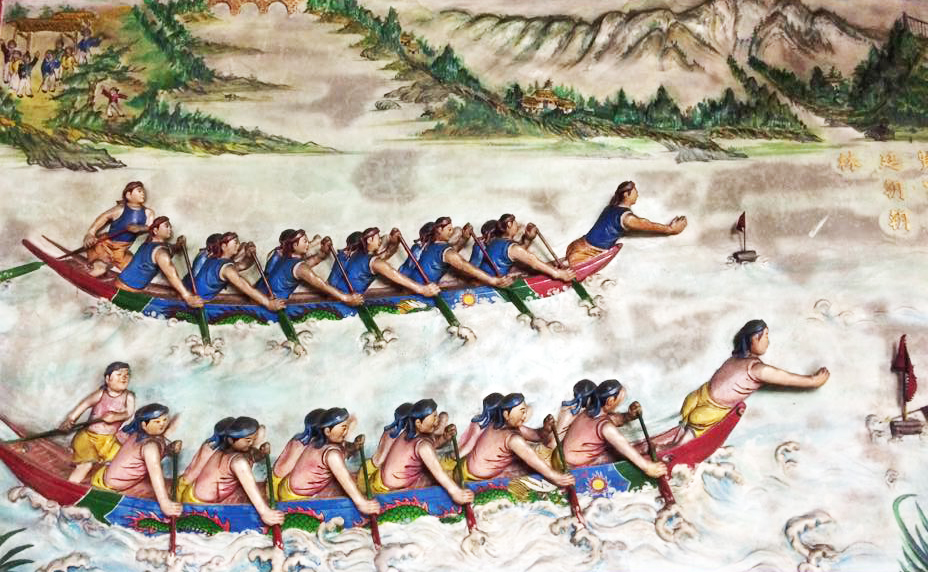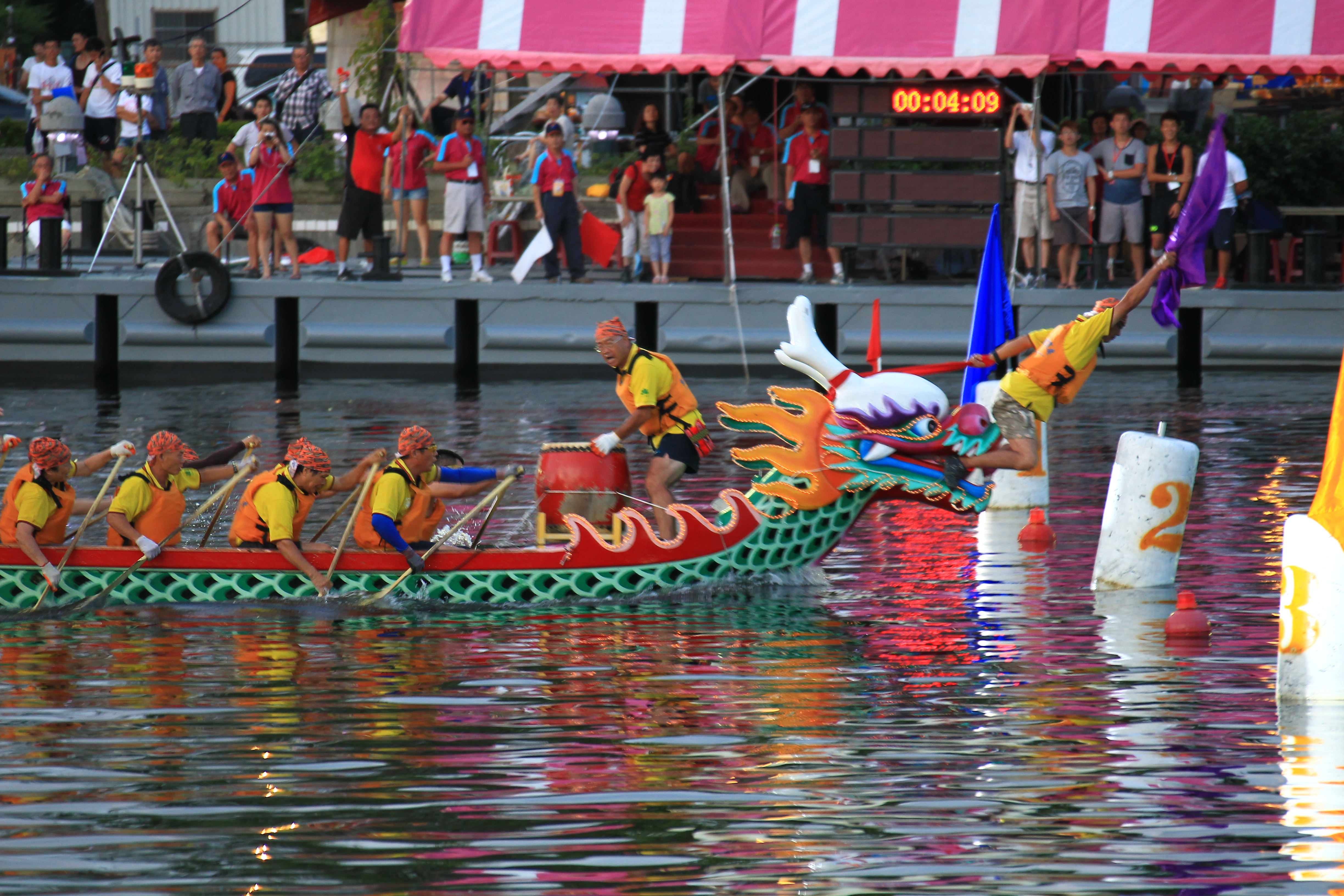As the spring season draws to a close and as the dog days of summer approach, the Taiwanese get ready for the Dragon Boat Festival—one of the most popular annual festivals celebrated across East Asia, from China to Hong Kong, Taiwan and Okinawa. The Korean Dano festival, Vietnam’s Tết Đoan Ngọ and Japan’s Kodomo no Hi all have historical links to the Dragon Boat Festival.

The Dragon Boat Festival (Taiwanese: Toan-ngó͘-chiat; Mandarin: Duānwǔjié), celebrated on the fifth day of the fifth lunar month, is also known as the Double Fifth Festival for that very reason. Children and families often look forward to the celebration for its games, activities, and food.
Different regions and cultures have different ways of celebrating the Dragon Boat Festival. Besides dragon boat races, the Taiwanese also celebrate the festival with other activities, such as making zòngzi rice dumplings, making scented sachets, hanging up mugworts and partaking in egg balancing competitions.
Before delving further into the activities themselves, let’s take a look at the legend that gave rise to the Dragon Boat Festival.
The festival’s roots date back to a time known as the Warring States (Zhànguó) period—a 254-year period from 475 to 221 BCE that preceded the creation of the first unified imperial Chinese state.
When the Romans were trying to unify Italy, many independent kingdoms existed in the Far Eastern lands that were eventually conquered by China’s First Emperor. One of these kingdoms was known as “Chu,” a southern frontier state in what is today known as the southern-central part of China. The origins of the Dragon Boat Festival lie in the life (and death) of a Chu poet and statesman living at the end of the Warring States period.
The said individual was known as Qū Yuán, and he is remembered for his contributions to the ancient poetic compilation known as The Songs of the South (Chǔ Cí). Today, however, he is mostly remembered for the manner of his death and the festival that arose in his honour.
In 278 BCE, the First Emperor’s kingdom—the Kingdom of Qin (pronounced Chin; origin of the name “China”)—was well on its way to creating “China.” The Qin suffered a severe defeat on the Kingdom of Chu and the Chu capital of Ying was overrun by invading Qin forces. By the close of the century, the Qin will have subdued all the warring states and establish the first Chinese Empire.
It is said that the famed Chu poet-statesman, Qū Yuán, was overcome by grief upon learning of the devastation suffered by his country at the hands of the Qin. He was said to have waded into the Miluo River where he drowned himself in an apparent ritual suicide to express his anguish.

Local villagers rushed out on their watercrafts and boats for a search and rescue mission, but their efforts were unsuccessful. In the end, all the villagers could do was toss rice, wrapped in bamboo leaves, into the river, serving as offerings to both to the spirit of Qū Yuán, as well as feed, to prevent the river fish from devouring Qū Yuán’s body. The rice tossed into the river is believed to be the origin of the custom of making zòngzi dumplings during the Dragon Boat Festival.
It is said that, in memory of the much-revered poet and statesman, the villagers held annual dragon boat races on the anniversary of his death to celebrate his achievements in life. This custom subsequently spread to many other places and has survived to the present.
Today, dragon boat racing is a worldwide phenomenon. The first international dragon boat race was held in Hong Kong in 1976 and the International Dragon Boat Federation was established in 1991. Dragon boat racing tournaments and championships are held annually across the world and the activity continues to rapidly grow in popularity.
Taiwanese dragon boat races arose from a hybrid of Chinese folk culture and pre-existing Indigenous boat-racing traditions. Taiwan’s dragon boats are constructed in the “sampan” style (Taiwanese: sam-pán; Mandarin: shānbǎn,) which refers to small traditional flat-bottom vessels.
The watercrafts are decorated with intricate patterns inspired by the mythical East Asian dragon; but beyond that basic principle, dragon boat designs are unique to their respective regions. Taiwanese vessels are colorful and their bodies are covered in dragon-scale motifs. The bows typically feature large, sculpted or moulded dragon heads and curled tails at the stern. Each dragon boat is also equipped with a large taiko-style drum or a hand-held gong. The designated drummer is tasked with providing a high-paced and rhythmic beat to effectively coordinate the oarsmen’s rowing efforts.
At the start of the races, the pupils in the eyes of the dragon boats are left blank. A ceremony called “Awakening the Dragon” is performed in which the pupils are literally “dotted” to awaken and invoke the dragon’s spirit. Dark red ink mixed with water from the river upon which the race is held is used to perform this ritual. A small amount of earth from the riverbank is also mixed into the ink. Once the ceremony is performed, the race is ready to begin.
According to Taiwanese practices, as each dragon boat approaches the finish line, a designated team member is charged with plucking a flag set afloat on a buoy free. The first team to successfully retrieve their flag is declared the winning team.

Besides dragon boat racing, a number of other activities are also associated with the Taiwanese Dragon Boat Festival.
The festival marks the coming of the summer months in Taiwan. The island’s subtropical climate means that, with the summer, comes the most active season for insect life. To ward off these bugs, the Taiwanese traditionally make and carry scented sachets packed with herbs and plants that deter insects. The custom of hanging up the mugwort plant near the entrance to one’s residence arose from the same practice.
Over time, people began to view these practices with supernatural elements and the purpose of “warding off malignant spirits” is given as an alternative explanation for the scented sachets and mugworts.


In China, egg balancing is associated with the March spring equinox. However, in Taiwan, egg balancing is a custom associated with the Dragon Boat Festival, which marks the beginning of summer.
The excitement of dragon boat racing is the highlight of the two-thousand-year-old Dragon Boat Festival, which has proven itself to still be popular in the 21st century. Other games and activities also complement the celebrations and make it one of the most popular of traditional folk festivals celebrated in Taiwan. All Taiwanese children and their families look forward to celebrating this summertime holiday each year!
Originally posted on Island Folklore. Reposted with permission.

È estremamente affascinante, la descrizione alquanto dettagliata è esaustiva. Credo che si tratti di una delle feste più tradizionali e di maggior interesse e coinvolgimento al mondo. Spero di poterla vivere per una volta personalmente, sarebbe per me come vivere la formazione di questo meraviglioso paese. Aggiungo che sarebbe tutto ancora più bello poterlo fare con una persona del posto al tuo fianco e poter condividere le emozioni.
LikeLike
Dragon Boat Festival is my favourite festival in Taiwan. I am a big sucker for Zong Zi! Taking part in a race is still on my bucket list for Taiwan.
LikeLike